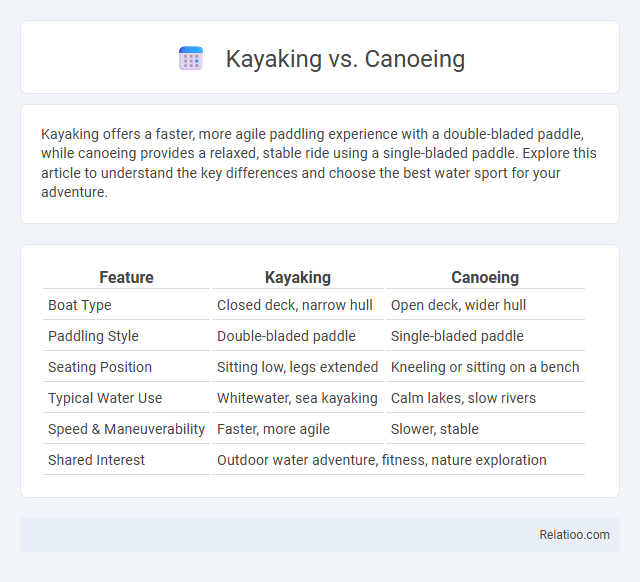Kayaking offers a faster, more agile paddling experience with a double-bladed paddle, while canoeing provides a relaxed, stable ride using a single-bladed paddle. Explore this article to understand the key differences and choose the best water sport for your adventure.
Table of Comparison
| Feature | Kayaking | Canoeing |
|---|---|---|
| Boat Type | Closed deck, narrow hull | Open deck, wider hull |
| Paddling Style | Double-bladed paddle | Single-bladed paddle |
| Seating Position | Sitting low, legs extended | Kneeling or sitting on a bench |
| Typical Water Use | Whitewater, sea kayaking | Calm lakes, slow rivers |
| Speed & Maneuverability | Faster, more agile | Slower, stable |
| Shared Interest | Outdoor water adventure, fitness, nature exploration | |
Key Differences Between Kayaking and Canoeing
Kayaking and canoeing differ primarily in boat design and paddling techniques, with kayaks being closed-deck vessels propelled by double-bladed paddles, while canoes are open-deck and use single-bladed paddles. Kayaking offers greater speed and maneuverability, making it ideal for white-water or sea adventures, whereas canoeing provides stability and ample space for gear, favored for leisurely river trips and extended camping excursions. Understanding these distinctions helps adventure enthusiasts choose the best water sport for their specific environment and outdoor objectives.
Types of Kayaks and Canoes
Sit-on-top kayaks offer stability and ease of use, ideal for beginners and recreational paddlers, while touring kayaks provide sleek designs for long-distance travel and enhanced speed. Canoes come in various types such as recreational canoes, versatile for calm waters, and whitewater canoes built with durability for navigating rapids. Adventure enthusiasts often select specialized kayaks or canoes tailored for specific environments like sea kayaks for ocean exploration or inflatable canoes for easy transport and rugged outdoor use.
Equipment and Gear Comparison
Kayaking gear typically includes a kayak with a closed cockpit, a double-bladed paddle, and a spray skirt for water protection, essential for maneuverability and control in diverse water conditions. Canoeing equipment consists of an open-top canoe, a single-bladed paddle, and often includes life vests and waterproof bags, emphasizing stability and cargo capacity for extended trips. Adventure enthusiasts prioritize versatile gear such as durable dry bags, multi-functional paddles, and adaptive footwear to ensure safety, comfort, and preparedness across kayaking and canoeing expeditions.
Paddle Techniques: Kayak vs Canoe
Kayak paddling involves a double-bladed paddle, allowing for efficient alternating strokes on both sides, which enhances speed and maneuverability in narrow waterways and rough waters. Canoe paddling uses a single-bladed paddle with various stroke techniques such as the J-stroke to maintain direction and balance, making it ideal for calm lakes and rivers. Mastery of these distinct paddling techniques directly impacts performance, safety, and the overall adventure experience in both kayaking and canoeing.
Water Conditions and Suitable Activities
Kayaking excels in rough, fast-moving waters such as rivers and ocean waves, making it ideal for whitewater rafting and coastal exploration. Canoeing performs best in calm lakes and gentle rivers, suited for leisurely paddling and wildlife observation. Adventure activities involving kayaking often include navigating rapids and surf zones, while canoeing favors serene environments for camping trips and family outings.
Safety Considerations for Both Sports
Kayaking and canoeing both require rigorous safety measures including wearing personal flotation devices (PFDs) and understanding water conditions to prevent accidents. Proper training in paddling techniques and rescue procedures significantly reduces the risk of capsizing or injury. Adventure enthusiasts should also consider weather forecasts, carry communication devices, and avoid isolated areas to enhance safety during their outdoor water activities.
Pros and Cons of Kayaking
Kayaking offers greater maneuverability and speed compared to canoeing, making it ideal for navigating narrow or fast-moving waters, though it can be less stable and more challenging for beginners. The enclosed cockpit design provides better protection from water and wind, enhancing comfort during long trips but limiting mobility and gear space compared to open canoes. While kayaking supports solo or tandem paddling, it demands more upper body strength and technique, which may deter casual or less experienced adventure seekers.
Pros and Cons of Canoeing
Canoeing offers a stable and versatile way to explore calm lakes, rivers, and scenic waterways, making it ideal for beginners and families. Its open design allows for easier gear storage and social paddling but can be less efficient for speed and maneuverability compared to kayaking. However, canoes are generally larger and heavier, which might require more effort to transport and navigate in rough waters.
Which Is Easier to Learn: Kayak or Canoe?
Kayaking is generally easier to learn than canoeing due to its stable design and simple paddling technique, making it ideal for beginners exploring outdoor adventures. Your balance and coordination improve quickly in a kayak, as the double-bladed paddle requires less skill to maneuver effectively compared to the single-bladed paddle used in canoeing. For those seeking an accessible entry into water sports, kayaking offers a smoother learning curve while providing thrilling adventure opportunities on lakes, rivers, and coastal waters.
Choosing the Right Option for You
Kayaking offers a faster, more agile experience with a narrow, closed-deck design ideal for navigating rapids, while canoeing provides stability and spaciousness, perfect for calm waters and carrying gear. Adventure seekers might prioritize the thrill of whitewater kayaking or the extended exploration potential of canoeing on remote lakes and rivers. Assess your skill level, desired activity intensity, and equipment needs to choose the right option that aligns with your outdoor adventure goals.

Infographic: Kayaking vs Canoeing
 relatioo.com
relatioo.com